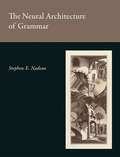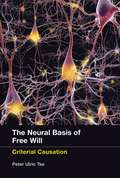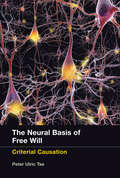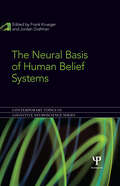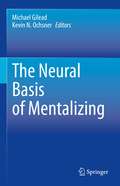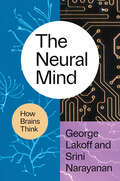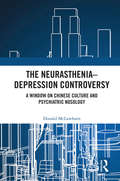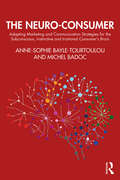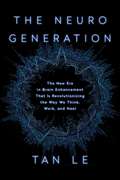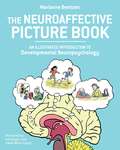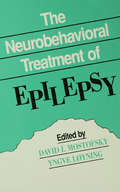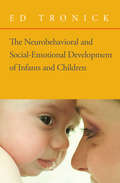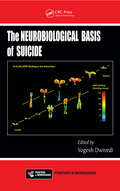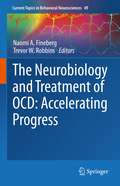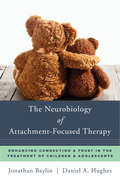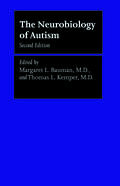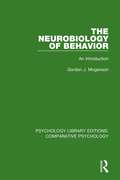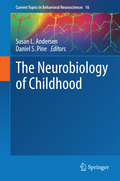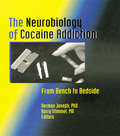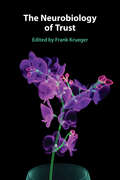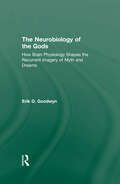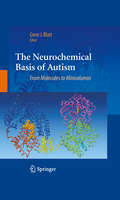- Table View
- List View
The Neural Architecture of Grammar (The\mit Press Ser.)
by Stephen E. NadeauA comprehensive, neurally based theory of language function that draws on principles of neuroanatomy, cognitive psychology, cognitive neuropsychology, psycholinguistics, and parallel distributed processing.Linguists have mapped the topography of language behavior in many languages in intricate detail. To understand how the brain supports language function, however, we must take into account the principles and regularities of neural function. Mechanisms of neurolinguistic function cannot be inferred solely from observations of normal and impaired language. In The Neural Architecture of Grammar, Stephen Nadeau develops a neurologically plausible theory of grammatic function. He brings together principles of neuroanatomy, neurophysiology, and parallel distributed processing and draws on literature on language function from cognitive psychology, cognitive neuropsychology, psycholinguistics, and functional imaging to develop a comprehensive neurally based theory of language function. Nadeau reviews the aphasia literature, including cross-linguistic aphasia research, to test the model's ability to account for the findings of these empirical studies. Nadeau finds that the model readily accounts for a crucial finding in cross-linguistic studies—that the most powerful determinant of patterns of language breakdown in aphasia is the predisorder language spoken by the subject—and that it does so by conceptualizing grammatic function in terms of the statistical regularities of particular languages that are encoded in network connectivity. He shows that the model provides a surprisingly good account for many findings and offers solutions for a number of controversial problems. Moreover, aphasia studies provide the basis for elaborating the model in interesting and important ways.
The Neural Basis Of Thought: The Diaries Of Escher, Bodmer, May And De Gallois 1814-18
by Campion, George G & Elliot Smith, GraftonFirst Published in 1999. Routledge is an imprint of Taylor & Francis, an informa company.
The Neural Basis of Free Will
by Peter Ulric TseThe issues of mental causation, consciousness, and free will have vexed philosophers since Plato. In this book, Peter Tse examines these unresolved issues from a neuroscientific perspective. In contrast with philosophers who use logic rather than data to argue whether mental causation or consciousness can exist given unproven first assumptions, Tse proposes that we instead listen to what neurons have to say. Because the brain must already embody a solution to the mind--body problem, why not focus on how the brain actually realizes mental causation? Tse draws on exciting recent neuroscientific data concerning how informational causation is realized in physical causation at the level of NMDA receptors, synapses, dendrites, neurons, and neuronal circuits. He argues that a particular kind of strong free will and "downward" mental causation are realized in rapid synaptic plasticity. Recent neurophysiological breakthroughs reveal that neurons function as criterial assessors of their inputs, which then change the criteria that will make other neurons fire in the future. Such informational causation cannot change the physical basis of information realized in the present, but it can change the physical basis of information that may be realized in the immediate future. This gets around the standard argument against free will centered on the impossibility of self-causation. Tse explores the ways that mental causation and qualia might be realized in this kind of neuronal and associated information-processing architecture, and considers the psychological and philosophical implications of having such an architecture realized in our brains.
The Neural Basis of Free Will: Criterial Causation
by Peter Ulric TseA neuroscientific perspective on the mind–body problem that focuses on how the brain actually accomplishes mental causation. The issues of mental causation, consciousness, and free will have vexed philosophers since Plato. In this book, Peter Tse examines these unresolved issues from a neuroscientific perspective. In contrast with philosophers who use logic rather than data to argue whether mental causation or consciousness can exist given unproven first assumptions, Tse proposes that we instead listen to what neurons have to say. Tse draws on exciting recent neuroscientific data concerning how informational causation is realized in physical causation at the level of NMDA receptors, synapses, dendrites, neurons, and neuronal circuits. He argues that a particular kind of strong free will and “downward” mental causation are realized in rapid synaptic plasticity. Such informational causation cannot change the physical basis of information realized in the present, but it can change the physical basis of information that may be realized in the immediate future. This gets around the standard argument against free will centered on the impossibility of self-causation. Tse explores the ways that mental causation and qualia might be realized in this kind of neuronal and associated information-processing architecture, and considers the psychological and philosophical implications of having such an architecture realized in our brains.
The Neural Basis of Human Belief Systems (Contemporary Topics in Cognitive Neuroscience)
by Jordan Grafman Frank KruegerIs the everyday understanding of belief susceptible to scientific investigation? Belief is one of the most commonly used, yet unexplained terms in neuroscience. Beliefs can be seen as forms of mental representations and one of the building blocks of our conscious thoughts. This book provides an interdisciplinary overview of what we currently know about the neural basis of human belief systems, and how different belief systems are implemented in the human brain. The chapters in this volume explain how the neural correlates of beliefs mediate a range of explicit and implicit behaviours ranging from moral decision making, to the practice of religion. Drawing inferences from philosophy, psychology, psychiatry, religion, and cognitive neuroscience, the book has important implications for understanding how different belief systems are implemented in the human brain, and outlines the directions which research on the cognitive neuroscience of beliefs should take in the future. The Neural Basis of Human Belief Systems will be of great interest to researchers in the fields of psychology, philosophy, psychiatry, and cognitive neuroscience.
The Neural Basis of Mentalizing
by Michael Gilead Kevin N. OchsnerHumans have a unique ability to understand the beliefs, emotions, and intentions of others—a capacity often referred to as mentalizing. Much research in psychology and neuroscience has focused on delineating the mechanisms of mentalizing, and examining the role of mentalizing processes in other domains of cognitive and affective functioning. The purpose of the book is to provide a comprehensive overview of the current research on the mechanisms of mentalizing at the neural, algorithmic, and computational levels of analysis.The book includes contributions from prominent researchers in the field of social-cognitive and affective neuroscience, as well as from related disciplines (e.g., cognitive, social, developmental and clinical psychology, psychiatry, philosophy, primatology). The contributors review their latest research in order to compile an authoritative source of knowledge on the psychological and brain bases of the unique human capacity to think about the mental states of others. The intended audience is researchers and students in the fields of social-cognitive and affective neuroscience and related disciplines such as neuroeconomics, cognitive neuroscience, developmental neuroscience, social cognition, social psychology, developmental psychology, cognitive psychology, and affective science. Secondary audiences include researchers in decision science (economics, judgment and decision-making), philosophy of mind, and psychiatry.
The Neural Code of Pitch and Harmony
by Langner, Gerald and Benson, Christina Gerald Langner Christina BensonHarmony is an integral part of our auditory environment. Resonances characterised by harmonic frequency relationships are found throughout the natural world and harmonic sounds are essential elements of speech, communication and, of course, music. Providing neurophysiological data and theories that are suitable to explain the neural code of pitch and harmony, the author demonstrates that musical pitch is a temporal phenomenon and musical harmony is a mathematical necessity based on neuronal mechanisms. Moreover, he offers new evidence for the role of an auditory time constant for speech and music perception as well as for similar neuronal processing mechanisms of auditory and brain waves. Successfully relating current neurophysiological results to the ancient ideas of Pythagoras, this unique title will appeal to specialists in the fields of neurophysiology, neuroacoustics, linguistics, behavioural biology and musicology as well as to a broader audience interested in the neural basis of music perception.
The Neural Mind: How Brains Think
by George Lakoff Srini NarayananOffers an expansive, unified theory of thought that brings together the vast resources of neuroscience, computation, and cognitive linguistics. What is an idea, and where does it come from? We experience thought as if it were abstract, but every thought is actually a physical thing, carried out by the neural systems of our brains. Thought does not occur neuron-by-neuron; it happens when neurons come together to form circuits and when simple circuits combine to form complex ones. Thoughts, then, derive their structures from the circuitry we also use for vision, touch, and hearing. This circuitry is what allows simple thoughts to come together into complex concepts, making meaning, creating metaphors, and framing our social and political ideas. With The Neural Mind, George Lakoff, a pioneering cognitive linguist, and computer scientist Srini Narayanan deftly combine insights from cognitive science, computational modeling, and linguistics to show how thoughts arise from the neural circuitry that runs throughout our bodies. They answer key questions about the ways we make meaning: How does neural circuitry create the conceptual “frames” through which we understand our social lives? What kind of neural circuitry characterizes metaphorical thought, in which ideas are understood in terms of other ideas with similar structures? Lively and accessible, the book shows convincingly that the “metaphors we live by”—to use Lakoff’s famous phrase—aren’t abstractions but deeply embodied neural constructs. The Neural Mind is the first book of its kind, bringing together the ideas of multiple disciplines to offer a unified, accessible theory of thought. A field-defining work, Lakoff and Narayanan’s book will be of interest not just to linguists and cognitive scientists but also to psychologists, philosophers, anthropologists, journalists, sociologists, and political scientists—and anyone who wants to understand how we really think.
The Neurasthenia-Depression Controversy: A Window on Chinese Culture and Psychiatric Nosology
by Donald McLawhornThis book is about the largest debate that has occurred in the field of cultural psychiatry and its impact on diagnosing, theorizing, and clinical practice. It is also about the role of culture in psychopathology specifically in relation to China. This book is the first comprehensive and critical assessment of the anthropological psychiatry that has provided Western physicians with their ideas about somatization and culture. It is argued that psychiatric nosology and the broader cultural milieu interact in a fascinating way and co-facilitate individual conformity to culturally salient categories, consciously or unconsciously, through a process of belief, expectation, and learning. The result is that codified experiences can be translated from the mind to the body and back again. Through a critical evaluation of the Neurasthenia-Depression controversy, we can gain a view of the contested and shifting nature of psychiatric nosology, and thereby attempt to introduce the beginnings of a model that elucidates how psychiatric distress varies across cultures. This timely book challenges conventional wisdom about neurasthenia and depression in Chinese societies. Its findings will be of value to anyone who works with Chinese people with these mental illnesses across the global diaspora.
The Neuro-Consumer: Adapting Marketing and Communication Strategies for the Subconscious, Instinctive and Irrational Consumer's Brain
by Michel Badoc Anne-Sophie Bayle-TourtoulouNeuroscientific research shows that the great majority of purchase decisions are irrational and driven by subconscious mechanisms in our brains. This is hugely disruptive to the rational, logical arguments of traditional communication and marketing practices and we are just starting to understand how organizations must adapt their strategies. This book explains the subconscious behavior of the "neuro-consumer" and shows how major international companies are using these findings to cast light on their own consumers’ behavior. Written in plain English for business and management readers with no scientific background, it focuses on: how to adapt marketing and communication to the subconscious and irrational behaviors of consumers; the direct influence of the primary senses (sight, hearing, smell, taste, touch) on purchasing decisions and the perception of communications by customers’ brains; implications for innovation, packaging, price, retail environments and advertising; the use of "nudges" and artifices to increase marketing and communication efficiency by making them neuro-compatible with the brain’s subconscious expectations; the influence of social media and communities on consumers’ decisions – when collective conscience is gradually replacing individual conscience and recommendation becomes more important than communication; and the ethical limits and considerations that organizations must heed when following these principles. Authored by two globally recognized leaders in business and neuroscience, this book is an essential companion to marketers and brand strategists interested in neuroscience and vital reading for any advanced student or researcher in this area.
The NeuroGeneration: The New Era in Brain Enhancement That Is Revolutionizing the Way We Think, Work, and Heal
by Tan LeBrain science is at the dawn of a new era—and the technologies emerging as a result could forever alter what it means to be human. Welcome to what tech pioneer and inventor Tan Le calls "the NeuroGeneration." It will blow your mind. The human brain is perhaps the most powerful and mysterious arrangement of matter in the known universe. New discoveries that unravel this mystery and let us tap into this power offer almost limitless potential—the ability to reshape ourselves and our thought processes, to improve our health and extend our lives, and to enhance and augment the ways we interact with the world around us. It may sound like the stuff of science fiction, but it is quickly becoming reality. In The NeuroGeneration, award-winning inventor Tan Le explores exciting advancements in brain science and neurotechnology that are revolutionizing the way we think, work, and heal. Join Le as she criss-crosses the globe, introducing the brilliant neurotech innovators and neuroscientists at the frontiers of brain enhancement. Along the way, she shares incredible stories from individuals whose lives are already being transformed by their inventions—an endurance racer paralyzed in a fall, who now walks thanks to neural stimulation and an exoskeleton; a man who drives a race car with his mind; even a color-blind "cyborg" whose brain implant allows him to "hear" colors. The NeuroGeneration reveals the dizzying array of emerging technologies—including cranial stimulation that makes you learn faster, an artificial hippocampus that restores lost memories, and neural implants that aim to help us keep up with or even outpace artificial intelligence—that promise to alter the brain in unprecedented ways, unlocking human potential we never dreamed possible. Le also explores how these futuristic innovations will impact our world, disrupt the way we do business, upend healthcare as we know it, and remake our lives in wondrous and unexpected ways. As fascinating as it is timely, The NeuroGeneration offers a thrilling glimpse of the future of our species, and how changing our brains can change human life as we know it.
The Neuroaffective Picture Book: An Illustrated Introduction to Developmental Neuropsychology
by Marianne Bentzen Kim Hagen Jakob Worre FogedAn illustrated introduction to the evolution and early development of the brain, emotions, and personalityDesigned for psychologists, psychotherapists, and childcare professionals, this book is an accessible primer on developmental neuropsychology, combining easy-to-understand text with light-hearted illustrations. Covering topics such as the autonomic nervous system, neuroaffective development, the prefrontal cortex, and the zone of proximal development, The Neuroaffective Picture Book is a unique and useful tool for learning about emotions, social skills, and self-regulation.
The Neurobehavioral Treatment of Epilepsy
by David I. Mostofsky Yngve LøyningThis volume is a first of its kind, addressed principally to the professional reader. While it is not intended to be exhaustive, its aim is to sketch a broad picture of some of the nondrug and nonsurgical treatment strategies with a demonstrated basis in conventional scientific method. Likewise, though it does not include all those who have contributed to the emergence of this exciting new field, it assembles those authors whose seminal work has earned them international reputations. This volume's declared purpose is to provide a state-of-the-art guide to methods and techniques in the behavioral treatment of epilepsy and to their basis in theory. The editors hope that it will catalyze the evolution of their acceptance as standard elements, where appropriate, in the clinical activities of independent practitioners, clinics, and agencies that service those with convulsive disorders.
The Neurobehavioral and Social-Emotional Development of Infants and Children (Norton Series on Interpersonal Neurobiology)
by Ed TronickInternationally recognized as one of the premier researchers on child development, Ed Tronick has held notable teaching positions and conducted vital research for nearly 30 years. Over the course of his esteemed career, he has received funding for hundreds of key studies in the US and abroad on normal and abnormal infant and child development--including his Mutual Regulation Model and Still-Face Paradigm, which revolutionized our understanding of infants' emotional capacities and coping--all of which led to critical contributions in the field. Much of his work serves as the benchmark for how mental health clinicians think about biopsychosocial states of consciousness, the process of meaning making, and how and why we engage with others in the world. Now, for the first time, Tronick has gathered together his most influential writings in a single, essential volume. Organized into five parts--(I) Neurobehavior, (II) Culture, (III) Infant Social-Emotional Interaction, (IV) Perturbations: Natural and Experimental, and (V) Dyadic Expansion of Consciousness and Meaning Making--this book represents his major ideas and studies regarding infant-adult interactions, developmental processes, and mutual regulation, carefully addressing such questions as: What is a state of consciousness? What are the developing infant's capacities for neurobehavioral self-organization? How are early infant-adult interactions organized? How can we understand the nature of normal versus abnormal development? How do self and mutual regulation relate to developmental processes? Is meaning making purely a function of the brain, or is it in our bodies as well? As a bonus, the book includes a DVD-ROM, with video clips of Tronick's Still-Face Paradigm, an invaluable teaching aid. Please note that the ebook version of this title does not include a CD.
The Neurobiological Basis of Suicide
by Yogesh DwivediWith recent studies using genetic, epigenetic, and other molecular and neurochemical approaches, a new era has begun in understanding pathophysiology of suicide. Emerging evidence suggests that neurobiological factors are not only critical in providing potential risk factors but also provide a promising approach to develop more effective treatment
The Neurobiology and Treatment of OCD: Accelerating Progress (Current Topics in Behavioral Neurosciences #49)
by Trevor W. Robbins Naomi A. FinebergThe book highlights important new research approaches of clinical relevance, written by prominent researchers in the field of OCD and related disorders. A broad range of topics is covered, beginning with a description of the phenotypic features of the OCD followed by chapters on developmental aspects, animal models, genetic and biological models including neuro-inflammation, functional neuroimaging correlates and information-processing accounts. Finally, existing and novel treatment approaches are covered including clinical and pharmacogenetic treatment models. In this way the volume brings together the key disciplines involved in the neurobiological understanding of OCD to provide an update of the field and outlook to the future. Together, the volume chapters provide focused and critical reviews that span a broad range of topics suitable for both students and established investigators and clinicians interested in the present state of OCD research.
The Neurobiology of Attachment-Focused Therapy: Enhancing Connection & Trust in the Treatment of Children & Adolescents (Norton Series on Interpersonal Neurobiology)
by Daniel A. Hughes Jonathan BaylinUniting attachment-focused therapy and neurobiology to help distrustful and traumatized children revive a sense of trust and connection. How can therapists and caregivers help maltreated children recover what they were born with: the potential to experience the safety, comfort, and joy of having trustworthy, loving adults in their lives? This groundbreaking book explores, for the first time, how the attachment-focused family therapy model can respond to this question at a neural level. It is a rich, accessible investigation of the brain science of early childhood and developmental trauma. Each chapter offers clinicians new insights--and powerful new methods--to help neglected and insecurely attached children regain a sense of safety and security with caring adults. Throughout, vibrant clinical vignettes drawn from the authors' own experience illustrate how informed clinical processes can promote positive change. Authors Baylin and Hughes have collaborated for many years on the treatment of maltreated children and their caregivers. Both experienced psychologists, their shared project has bee the development of the science-based model of attachment-focused therapy in this book--a model that links clinical interventions to the crucial underlying processes of trust, mistrust, and trust building--helping children learn to trust caregivers and caregivers to be the "trust builders" these children need. The book begins by explaining the neurobiology of blocked trust, using the latest social neuroscience to show how the child's early development gets channeled into a core strategy of defensive living. Subsequent chapters address, among other valuable subjects, how new research on behavioral epigenetics has shown ways that highly stressful early life experiences affect brain development through patterns of gene expression, adapting the child's brain for mistrust rather than trust, and what it means for treatment approaches. Finally, readers will learn what goes on in the child's brain during attachment-focused therapy, honing in on the dyadic processes of adult-child interaction that seem to embody the core "mechanisms of change": elements of attachment-focused interventions that target the child's defensive brain, calm this system, and reopen the child's potential to learn from new experiences with caring adults, and that it is safe to depend upon them. If trust is to develop and care is to be restored, clinicians need to know what prevents the development of trust in the first place, particularly when a child is living in an environment of good care for a long period of time. What do abuse and neglect do to the development of children's brains that makes it so difficult for them to trust adults who are so different from those who hurt them? This book presents a brain-based understanding that professionals can apply to answering these questions and encouraging the development of healthy trust.
The Neurobiology of Autism (The Johns Hopkins Series in Psychiatry and Neuroscience)
by Margaret L. BaumanIn the decade since the first edition of The Neurobiology of Autism was published, research has revealed valuable new information about the nature and origins of autism, including genetics and abnormalities in such neurotransmitters as acetylcholine and serotonin. For this long-anticipated new edition, neurologists Margaret L. Bauman and Thomas L. Kemper bring together leading researchers and clinicians to present the most current scientific knowledge and theories about autism. The contributors cover genetics, imaging studies, physiology, neuroanatomy and neurochemistry, immunology, brain function, the epidemiology of the disease, and related disorders. Thoroughly updated, The Neurobiology of Autism remains the best single-volume work on the wide array of research being conducted into the causes, characteristics, and treatment of autism.Contributors: George M. Anderson, Yale Child Study Center; Tara L. Arndt, University of Rochester Medical Center (URMC); Trang Au, University of Massachusetts Medical School (UMMC); Jocelyne Bachevalier, University of Texas Health Science Center; Irina N. Bespalova, Seaver Autism Research Center, Mt. Sinai School of Medicine (SARC); Gene J. Blatt, Boston University School of Medicine (BUSM); Susan E. Bryson, IWK Health Centre–Dalhousie University; Timothy M. Buie, Massachusetts General Hospital (MGH); Joseph D. Buxbaum, SARC; Kathryn M. Carbone, The Johns Hopkins University School of Medicine (JHUSM); Diane C. Chugani, Wayne State University; Daniel F. Connor, UMMC; Edwin H. Cook, Jr., University of Chicago; S. Hossein Fatemi, University of Minnesota Medical School; Susan E. Folstein, Tufts University School of Medicine; Eric Fombonne, McGill University; Randi Jenssen Hagerman, UC Davis Medical Center; Elizabeth Petri Henske, Fox Chase Cancer Center, Philadelphia; Jeannette J. A. Holden, Queen's University; Ronald J. Killiany, BUSM; Omanand Koul, UMMC; Mandy Lee, Newcastle General Hospital, U.K.; Xudong Liu, Queen's University; Tara L. Moore, BUSM; Mark B. Moss, BUSM; Karin B. Nelson, National Institute of Neurological Disorders and Stroke; Phillip G. Nelson, National Institute of Child Health and Human Development; Elaine Perry, Newcastle General Hospital; Jonathan Pevsner, JHUSM; Mikhail V. Pletnikov, JHUSM; Stephen W. Porges, University of Illinois at Chicago; Lucio Rehbein, Universidad de la Frontera, Chile; Jennifer Reichert, SARC; Patricia M. Rodier, URMC; Beth Rosen-Sheidley, MGH; Susan L. Smalley, UCLA Neuropsychiatric Research Institute; Ronald J. Steingard, UMMC; Helen Tager-Flusberg, BUSM; Gary L. Wenk, University of Arizona; Andrew W. Zimmerman, JHUSM
The Neurobiology of Behavior: An Introduction (Psychology Library Editions: Comparative Psychology)
by Gordon J. MogensonOriginally published in 1977, the objective of this book was to examine the mechanisms by which the multiple factors or determinants – homeostatic deficits, hormonal influences, circadian rhythms, experiential and cognitive factors – become translated by the central nervous system into thermoregulatory, feeding, sexual, aggressive, and other behaviours. A conceptual framework has been used that reflects relevant contributions from biology, regulatory physiology, physiological psychology, and other neuroscience disciplines. The final chapter deals with difficulties in brain-behaviour research in relation to experimental strategies and with crucial problems for future investigation.
The Neurobiology of Childhood
by Susan L. Andersen Daniel S. PineDuring the past years there has been rapid progress in the understanding of how early life stress impacts psychopathology in children. The first two parts of this book present the basic principles of brain development and describe the most important neuronal systems This includes systems involved in emotion processing, cognitive control, and social processes These first two general sections are followed by an overview about recent research on various neuronal and psychiatric disorders, where environmental exposures and altered brain development play an important role: sleep, autism, ADHD and other developmental forms of psychopathology.
The Neurobiology of Childhood (Current Topics in Behavioral Neurosciences #16)
by Susan L. Andersen and Daniel S. PineDuring the past years there has been rapid progress in the understanding of how early life stress impacts psychopathology in children. The first two parts of this book present the basic principles of brain development and describe the most important neuronal systems. This includes systems involved in emotion processing, cognitive control, and social processes. These first two general sections are followed by an overview about recent research on various neuronal and psychiatric disorders, where environmental exposures and altered brain development play an important role: sleep, autism, ADHD and other developmental forms of psychopathology.
The Neurobiology of Cocaine Addiction: From Bench to Bedside
by Herman Joseph Regina QuattrochiWith the use of crack on the rise in American cities, there is more need than ever to understand the biological, environmental, and social factors behind cocaine addiction, as well as the pharmacological properties of cocaine that make it such an addictive drug. The Neurobiology of Cocaine Addiction helps clinicians and researchers analyze research findings and their relevance to the clinical treatment of cocaine dependency. To do this, it looks at the whole spectrum of cocaine use, from trends in cocaine-involved deaths, hospital emergencies, arrests, and treatment admissions to the specific impact the drug has on brain function. The book reports on important findings from positron emission tomography (PET) and a “binge” pattern cocaine administration mode. This will enable you to improve your understanding of how cocaine alters the pleasure/reward system of the brain and creates new instinctual needs that displace the inherent instinctual needs of hunger and sex.By reading The Neurobiology of Cocaine Addiction, you will sharpen your knowledge of the basic actions of cocaine, the factors related to daily cocaine use, the neurobiological basis of addictive diseases, and drug-induced alterations in normal physiology. You will also learn about: the coexistence of cocaine and heroin addiction cocaine&’s disruption of the endogenous opioid system QEEG and how it can play a potentially useful role in drug development and planning hypotheses of sensitization in the pathophysiology of cocaine dependence factors that predict daily cocaine use among patients in a methadone maintenance program abnormalities in brain function that persist for up to six months after last cocaine use patterns of cocaine use the importance of prospective data analysis and the limitations of a self-selective study groupClinicians, researchers, psychiatrists, and other professionals in chemical dependency and narcotics rehabilitation will turn the last page of The Neurobiology of Cocaine Addiction with a better understanding of cocaine&’s addictive qualities and the characteristics of the individuals who become addicted to it. You will see what headway has been made in research at some of the nation&’s top laboratories, but you will also see what remains to be done. Hopefully, you will find where you can make a contribution either at the practical level, the research level, or both.
The Neurobiology of Trust
by Frank KruegerTrust is essential for establishing and maintaining cooperative behaviors between individuals and institutions in a wide variety of social, economic, and political contexts. This book explores trust through the lens of neurobiology, focusing on empirical, methodological, and theoretical aspects. Written by a distinguished group of researchers from economics, psychology, human factors, neuroscience, and psychiatry, the chapters shed light on the neurobiological underpinnings of trust as applied in a variety of domains. Researchers and students will discover a refined understanding of trust by delving into the essential topics in this area of study outlined by leading experts.
The Neurobiology of the Gods: How Brain Physiology Shapes the Recurrent Imagery of Myth and Dreams
by Erik D. GoodwynWhere does science end and religion begin? Can "spiritual" images and feelings be understood on a neurobiological level without dismissing their power and mystery? In this book, psychiatrist Erik Goodwyn addresses these questions by reviewing decades of research, putting together a compelling argument that the emotional imagery of myth and dreams can be traced to our deep brain physiology, and importantly, how a sensitive look at this data reveals why mythic or religious symbols are indeed more "godlike" than we might have imagined. The Neurobiology of the Gods weaves together Jungian depth psychology with research in evolutionary psychology, neuroanatomy, cognitive science, neuroscience, anthropology, mental imagery, dream research, and metaphor theory into a comprehensive model of how our brains contribute to the recurrent images of dreams, myth, religion and even hallucinations. Divided into three sections, this book provides: definitions and foundations an examination of individual symbols conclusive thoughts on how brain physiology shapes the recurring images that we experience. Goodwyn shows how common dream, myth and religious experiences can be meaningful and purposeful without discarding scientific rigor. The Neurobiology of the Gods will therefore be essential reading for Jungian analysts and psychologists as well as those with an interest in philosophy, anthropology and the interface between science and religion.
The Neurochemical Basis of Autism
by Gene J. BlattThe Neurochemical Basis of Autism: From Molecules to Minicolumns is a uniquely interdisciplinary text that presents the latest findings regarding the physiological, neuropathological, neurochemical and clinical elements of autism. This book contains an array of unique perspectives on autism from top researchers, beginning with a clinical perspective that discusses etiologies, early identification, advancements in care and associated disorders. It then covers topics such as neuropathological changes in autism to the pre- and post-natal development timing of the disorder, changes in the cerebellum in autism, the role of oxytocin in autism, the relationship of oxidative stress and autism, and a comprehensive review of pharmacotherapies, as well as the hypotheses being used to explore its causes and cures. Lay abstracts make this book as accessible to the parents and caretakers of autistic children as it is indispensable to the scientists, researchers and clinicians on the front line of this affliction.
